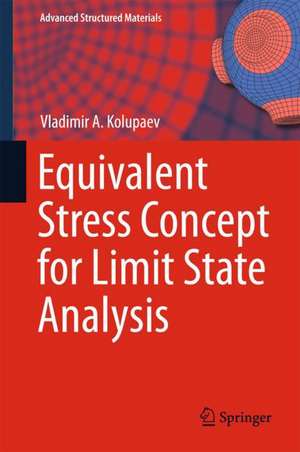Equivalent Stress Concept for Limit State Analysis: Advanced Structured Materials, cartea 86
Autor Vladimir A. Kolupaeven Limba Engleză Hardback – 29 ian 2018
The most useful criteria can be applied best when the plausibility assumptions are known. Accordingly, the book introduces fitting methods based on mathematical, physical, and geometrical objective functions. It also features a wealth of examples that demonstrate the application of different approaches in modeling certain limit behaviors.
| Toate formatele și edițiile | Preț | Express |
|---|---|---|
| Paperback (1) | 644.63 lei 6-8 săpt. | |
| Springer International Publishing – 7 iun 2019 | 644.63 lei 6-8 săpt. | |
| Hardback (1) | 651.02 lei 6-8 săpt. | |
| Springer International Publishing – 29 ian 2018 | 651.02 lei 6-8 săpt. |
Din seria Advanced Structured Materials
- 18%
 Preț: 949.90 lei
Preț: 949.90 lei - 18%
 Preț: 1011.27 lei
Preț: 1011.27 lei - 18%
 Preț: 1014.28 lei
Preț: 1014.28 lei - 18%
 Preț: 1109.16 lei
Preț: 1109.16 lei - 18%
 Preț: 1034.17 lei
Preț: 1034.17 lei - 15%
 Preț: 713.69 lei
Preț: 713.69 lei - 18%
 Preț: 1007.35 lei
Preț: 1007.35 lei - 18%
 Preț: 899.21 lei
Preț: 899.21 lei - 18%
 Preț: 1116.26 lei
Preț: 1116.26 lei - 18%
 Preț: 1120.99 lei
Preț: 1120.99 lei - 18%
 Preț: 785.55 lei
Preț: 785.55 lei - 18%
 Preț: 894.46 lei
Preț: 894.46 lei - 18%
 Preț: 1222.01 lei
Preț: 1222.01 lei - 18%
 Preț: 993.12 lei
Preț: 993.12 lei - 18%
 Preț: 792.66 lei
Preț: 792.66 lei - 18%
 Preț: 807.64 lei
Preț: 807.64 lei - 18%
 Preț: 1007.35 lei
Preț: 1007.35 lei - 18%
 Preț: 1120.18 lei
Preț: 1120.18 lei - 18%
 Preț: 1233.06 lei
Preț: 1233.06 lei - 18%
 Preț: 748.46 lei
Preț: 748.46 lei - 18%
 Preț: 1106.00 lei
Preț: 1106.00 lei - 18%
 Preț: 753.20 lei
Preț: 753.20 lei - 18%
 Preț: 780.82 lei
Preț: 780.82 lei - 18%
 Preț: 803.40 lei
Preț: 803.40 lei - 18%
 Preț: 798.18 lei
Preț: 798.18 lei - 18%
 Preț: 1123.35 lei
Preț: 1123.35 lei - 18%
 Preț: 901.64 lei
Preț: 901.64 lei - 18%
 Preț: 731.91 lei
Preț: 731.91 lei - 18%
 Preț: 947.04 lei
Preț: 947.04 lei - 15%
 Preț: 643.65 lei
Preț: 643.65 lei - 15%
 Preț: 639.25 lei
Preț: 639.25 lei - 15%
 Preț: 661.65 lei
Preț: 661.65 lei - 18%
 Preț: 953.82 lei
Preț: 953.82 lei - 15%
 Preț: 646.62 lei
Preț: 646.62 lei - 18%
 Preț: 1229.10 lei
Preț: 1229.10 lei - 15%
 Preț: 637.78 lei
Preț: 637.78 lei - 15%
 Preț: 651.84 lei
Preț: 651.84 lei - 15%
 Preț: 641.71 lei
Preț: 641.71 lei - 15%
 Preț: 649.22 lei
Preț: 649.22 lei - 15%
 Preț: 658.70 lei
Preț: 658.70 lei - 5%
 Preț: 719.59 lei
Preț: 719.59 lei - 15%
 Preț: 645.79 lei
Preț: 645.79 lei - 15%
 Preț: 646.43 lei
Preț: 646.43 lei - 18%
 Preț: 936.29 lei
Preț: 936.29 lei - 18%
 Preț: 1231.16 lei
Preț: 1231.16 lei
Preț: 651.02 lei
Preț vechi: 765.90 lei
-15% Nou
124.57€ • 130.07$ • 102.87£
Carte tipărită la comandă
Livrare economică 15-29 aprilie
Specificații
ISBN-10: 3319730487
Pagini: 242
Ilustrații: XVII, 365 p. 210 illus., 205 illus. in color.
Dimensiuni: 155 x 235 mm
Greutate: 0.71 kg
Ediția:1st ed. 2018
Editura: Springer International Publishing
Colecția Springer
Seria Advanced Structured Materials
Locul publicării:Cham, Switzerland
Cuprins
Introduction.- Criteria of Equivalent Stress Concept.-Visualization Methods.- Formulations of Classical Strength.- Values for Comparison.- Visualization of Standard Criteria.- Alternative Formulations of Standard Criteria.- Conditions and Assumptions of Strength Criteria.- Generalized Pressure-Insensitive Criteria.- Generalized Pressure-Sensitive Criteria.- Multi-Surface Criteria.- Fitting of Criteria.- Experiments & Equipment.- Applications. Summary and Outlook.
Textul de pe ultima copertă
This book discusses arbitrary multiaxial stress states using the concept of equivalent stress. It highlights the most useful criteria, which can be applied to various classes of isotropic materials. Due to its simplicity and clarity, this concept is now widely used in component design, and many strength and yield criteria based on the equivalent stress concept have been formulated. Choosing the appropriate criterion for a given material remains the main challenge in applications.
The most useful criteria can be applied best when the plausibility assumptions are known. Accordingly, the book introduces fitting methods based on mathematical, physical, and geometrical objective functions. It also features a wealth of examples that demonstrate the application of different approaches in modeling certain limit behaviors.
Caracteristici
Highlights the most useful criteria, which can be applied to various classes of isotropic materials
Includes a wealth of examples demonstrating different approaches to modeling limit behaviors
Descriere
This book discusses arbitrary multiaxial stress states using the concept of equivalent stress. It highlights the most useful criteria, which can be applied to various classes of isotropic materials. Due to its simplicity and clarity, this concept is now widely used in component design, and many strength and yield criteria based on the equivalent stress concept have been formulated. Choosing the appropriate criterion for a given material remains the main challenge in applications.
The most useful criteria can be applied best when the plausibility assumptions are known. Accordingly, the book introduces fitting methods based on mathematical, physical, and geometrical objective functions. It also features a wealth of examples that demonstrate the application of different approaches in modeling certain limit behaviors.
